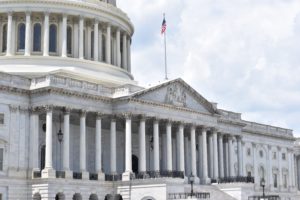
The government of the United States is a federal democratic republic, meaning that it is a federation of states with a representative democracy. The government is divided into three branches: the legislative, executive, and judicial.
The legislative branch is made up of Congress, which is further divided into two parts: the Senate and the House of Representatives. The Senate is made up of 100 Senators, two from each state, while the House of Representatives is made up of 435 members, apportioned according to the population of each state. Congress has the power to make laws and approve or reject the nominations of the President.
The executive branch is headed by the President, who is the head of state and government, and is responsible for enforcing the laws that Congress passes. The President is also the commander-in-chief of the military and has the power to negotiate treaties and make appointments to the federal government, including the Supreme Court. The Vice President is second-in-command to the President and assumes the presidency if the President is unable to fulfill their duties.
The judicial branch is made up of the Supreme Court and other federal courts, which interpret and apply the laws of the United States. The Supreme Court is the highest court in the land and is made up of nine justices appointed by the President and confirmed by the Senate.
The government of the United States also has a system of checks and balances, meaning that each branch of government has certain powers and responsibilities that allow it to keep the other branches in check. This helps to prevent any one branch from gaining too much power and ensures that the government operates in a balanced and fair manner.
Resources for more information:
- The United States Constitution: This is the foundational document of the US government, outlining its structure and powers. It is available online at the National Archives website: https://www.archives.gov/founding…/constitution-transcript
- The Federalist Papers: A series of essays written in the late 18th century by Alexander Hamilton, James Madison, and John Jay, the Federalist Papers provide insight into the motivations and thinking behind the creation of the US Constitution. They are available online at the Library of Congress website: https://guides.loc.gov/federalist-papers/full-text
- “Civics 101” podcast: This podcast series produced by New Hampshire Public Radio provides a comprehensive overview of the US government and its institutions. You can find episodes on various topics, including the Constitution, the three branches of government, and the electoral process, at the NHPR website: https://www.nhpr.org/show/ask-civics-101
- The Congressional Research Service: This nonpartisan research arm of the US Congress provides information and analysis on a wide range of policy issues. Its reports are available to the public through the Library of Congress website: https://www.loc.gov/crsinfo/
- “How Our Laws Are Made” by the House of Representatives: This resource provides a detailed explanation of the process by which a bill becomes a law in the US Congress. It is available on the House of Representatives website: nhttps://www.house.gov/…/the-legislative-process/resources
